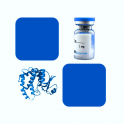
- Remove this product from my favorite's list.
- Add this product to my list of favorites.
Products
Newsletter
 |  |  |  |  |  |

Background
Fatty acid-binding protein 2 (FABP2), is also known as Fatty acid-binding protein, intestinal (FABPI), Intestinal-type fatty acid-binding protein (I-FABP). FABP2 belongs to the calycin superfamily and Fatty-acid binding protein (FABP) family. FABP2 / FABPI is expressed in the small intestine and at much lower levels in the large intestine and is highest expressed in the jejunum. FABP are thought to play a role in the intracellular transport of long-chain fatty acids and their acyl-CoA esters. FABP2 is probably involved in triglyceride-rich lipoprotein synthesis. FABP2 binds saturated long-chain fatty acids with a high affinity, but binds with a lower affinity to unsaturated long-chain fatty acids. FABP2 may also help maintain energy homeostasis by functioning as a lipid sensor.
Source
Recombinant Human FABP2, His Tag (FA2-H5149) is expressed from E.coli cells. It contains AA Ala 2 - Asp 132 (Accession # P12104-1).
Predicted N-terminus: Met
Molecular Characterization
This protein carries a polyhistidine tag at the N-terminus.
The protein has a calculated MW of 16.1 kDa. The protein migrates as 15 kDa under reducing (R) condition (SDS-PAGE).
Endotoxin
Less than 1.0 EU per μg by the LAL method.
Purity
>98% as determined by SDS-PAGE.
Formulation
Lyophilized from 0.22 μm filtered solution in PBS, pH7.4. Normally trehalose is added as protectant before lyophilization.
Reconstitution
See Certificate of Analysis for reconstitution instructions and specific concentrations.
For best performance, we strongly recommend you to follow the reconstitution protocol provided in the CoA.
Storage
For long term storage, the product should be stored at lyophilized state at -20°C or lower.
Please avoid repeated freeze-thaw cycles.
This product is stable after storage at:
-20°C to -70°C for 12 months in lyophilized state;
-70°C for 3 months under sterile conditions after reconstitution.
(1) "Millet Bran Protein Hydrolysate Displays the Anti-non-alcoholic Fatty Liver Disease Effect via Activating Peroxisome Proliferator-Activated Receptor γ to Restrain Fatty Acid Uptake"
Shan, Zhou, Yin et al
J Agric Food Chem (2023)
(2) "The effects of dietary supplementation with mushroom or selenium enriched mushroom powders on the growth performance and intestinal health of post-weaned pigs"
Dowley, Sweeney, Conway et al
J Anim Sci Biotechnol (2023) 14 (1), 12
(3) "Effects of Flavonoid-Rich Orange Juice Intervention on Major Depressive Disorder in Young Adults: A Randomized Controlled Trial"
Choi, Kim, Park et al
Nutrients (2022) 15 (1)
Showing 1-3 of 518 papers.
Welcome Login
Contact us
Follow us